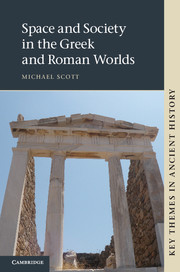Book contents
- Frontmatter
- Contents
- Illustrations
- Acknowledgements
- Abbreviations
- Introduction
- Chapter 1 Inheriting and articulating a community
- Chapter 2 Networks of polytheism: spaces for the gods at Delos
- Chapter 3 Spaces of alienation: street-lining Roman cemeteries
- Chapter 4 A spatial approach to relationships between colony and metropolis
- Chapter 5 The place of Greece in the oikoumene of Strabo’s Geography
- Conclusion: space and society in the Greek and Roman worlds
- Bibliographic essay
- Bibliography
- Index
Chapter 2 - Networks of polytheism: spaces for the gods at Delos
Published online by Cambridge University Press: 05 December 2012
- Frontmatter
- Contents
- Illustrations
- Acknowledgements
- Abbreviations
- Introduction
- Chapter 1 Inheriting and articulating a community
- Chapter 2 Networks of polytheism: spaces for the gods at Delos
- Chapter 3 Spaces of alienation: street-lining Roman cemeteries
- Chapter 4 A spatial approach to relationships between colony and metropolis
- Chapter 5 The place of Greece in the oikoumene of Strabo’s Geography
- Conclusion: space and society in the Greek and Roman worlds
- Bibliographic essay
- Bibliography
- Index
Summary
Introduction
The island of Delos, despite its small size, enjoyed a critical importance in the ancient Greek and Roman worlds. In myth, it was the spot where Leto gave birth to Apollo and Artemis. In the Archaic and Classical Periods it was home to an increasingly important cluster of religious sanctuaries that became the centre of a series of international groupings including, most famously, the Delian League. In the Hellenistic Period its religious and commercial communities grew enormously, attracting divinities, worshippers and traders from all over the ancient world, making it one of the most cosmopolitan communities in the Mediterranean (cf. Figures 2.1, 2.2, 2.10). In the Roman world, its convenient midway location in the Aegean and accessible free port facilitated continued and increasing commercial success, as well as its eventual destruction due to ongoing pirate raids and invasions.
What makes Delos even more distinctive, however, especially for those studying the ancient world today, is the extraordinary breadth of the surviving evidence for its activities. Literary sources including the Homeric Hymn to Delian Apollo, Thucydides and Callimachus combine with a mass of epigraphical data as well as the plentiful archaeological evidence for the religious, athletic and civic landscape of the island (cf. Figure 2.1). Above all, the picture presented to us by this wealth of evidence is of a Delos that became an increasingly cosmopolitan community over time, worshipping a combination of many local, Hellenic and foreign cults, assimilated and syncretised in an imaginative number of ways (Bruneau 1970; Bruneau and Ducat 2005: 49–53, 58–9, 64).
- Type
- Chapter
- Information
- Space and Society in the Greek and Roman Worlds , pp. 45 - 76Publisher: Cambridge University PressPrint publication year: 2012



